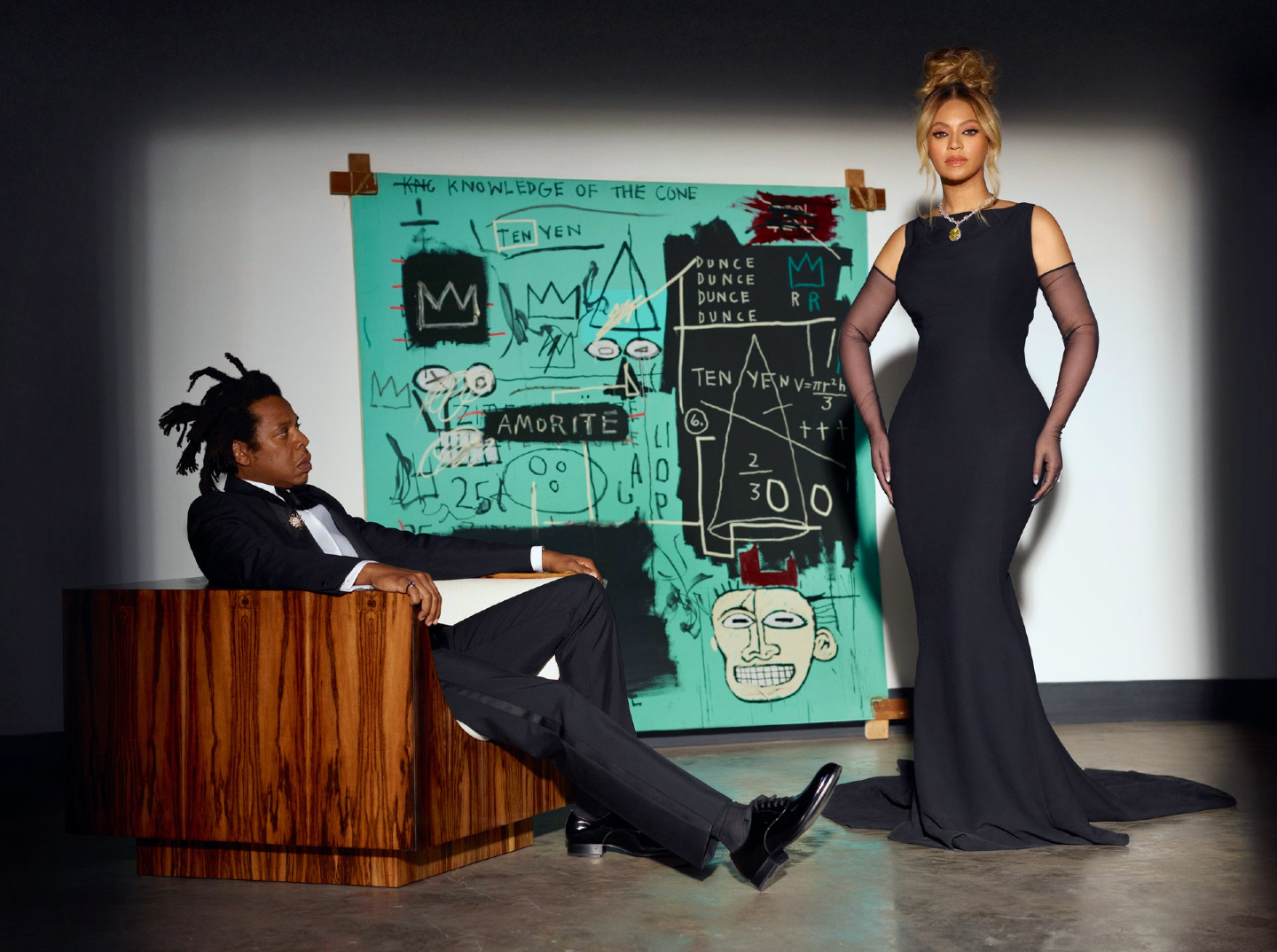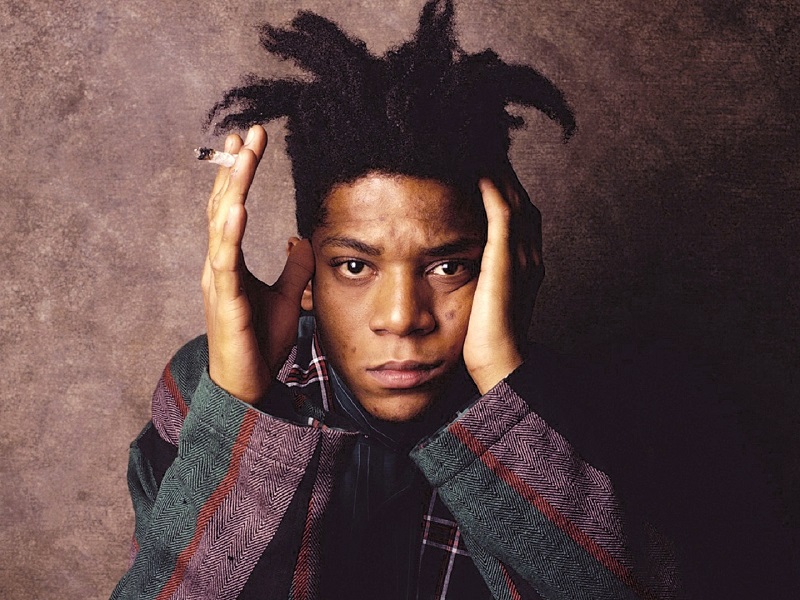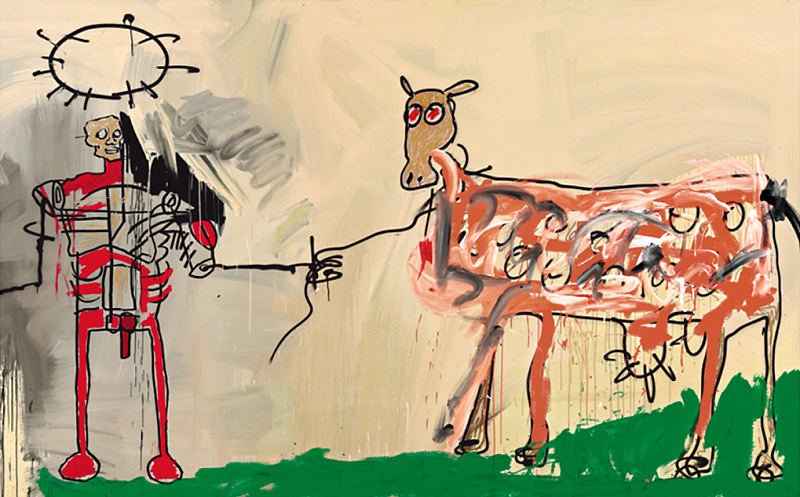
Jay-Z and Beyoncé recently headlined an ad campaign by US-based jeweller Tiffany & Co (Photo: Mason Poole)
A few weeks ago, the worlds of luxury fashion and art collided with a buzz of excitement we had not seen much of lately, when America’s “royal” music couple Beyoncé and Jay-Z headlined an ad campaign by US-based jeweller Tiffany & Co.
The “About Love” campaign triggered myriad reactions and divided sentiments. The internet went into overdrive, particularly as the campaign marked the first time the iconic 128.54-carat Tiffany Diamond was worn by a Black woman.
But before that, there was another reason for the attention. In a show-stealing move, the campaign features a very rare Basquiat painting with a distinctive robin’s-egg blue background, which incidentally is very similar to Tiffany’s signature tone.
Displayed just behind a tuxedo-attired Jay Z and a regal looking Beyoncé — both dressed in black — in several visual iterations, the painting is meant to catch the eye as the only aspect hinting at the brand’s colour.
There have been many marriages of high art and fashion, but the rarity of this 1982 painting, Equals Pi, and the intrigue of its uncommon colour lends an extra thrill because it is a work by Jean-Michel Basquiat, a name that elicits enduring veneration in the art world and beyond.
Equals Pi was created in what many regard as the most coveted year in Basquiat’s prolific decade-long career. First appearing in a 1983 issue of GQ magazine, the somewhat obscure piece had been offered for auction a couple of times before the Milan-based Sabbadini family of jewellers acquired it in 1996. It likely sat in their private living room until last month, when LVMH bought it for between US$15 million and US$20 million, according to art market website Artnet.
tco_beyonce_jay-z_basquiat.jpg

Soon, after making the rounds across digital billboards in Times Square, New York, the work will find its new home at Tiffany & Co’s Fifth Avenue store, which is currently undergoing renovations.
But what would Basquiat make of all this if he were alive today and still making art? Tiffany’s vice-president of products and communications Alexandre Arnault seems to think that he may approve.
“We know he loved New York, and that he loved luxury, and he loved jewellery. My guess is the [blue painting] is not by chance. The colour is so specific that it has to be some kind of homage,” he told fashion publication Women’s Wear Daily.
Well, it wouldn’t be Basquiat’s first foray into fashion, though not so much in his art but more of a personal interest. Having an elegant, if nonchalant, style, he had a taste for European suits, but was said to treat those from the likes of Armani, Versace and Gucci like overalls, having no qualms about spraying paint all over them as he worked if he happened to be wearing one. He also found interest in Japanese designers, most notably Rei Kawakubo’s Comme des Garçons, for whom he famously walked the runway in its 1987 Spring/Summer collection in Paris.
Then again, who really knows how Basquiat, viewed as an enigma, would react. Even today, decades after his passing from a heroin overdose in 1988 at the age of 27, people are still reading into his legacy in their own ways.
Most would describe him as a young prodigy who walked his own path, even if the puzzles of the pieces that make up Basquiat — much like his art — can be polarising and conflicting.
basquiat_1.jpg

Revered as a genius by some and criticised by others for his “grotesque and childish” art, he was a graffiti artist turned professional painter who favoured poetry and jazz as much as hip hop; a rebel who was very critical of the art market, and yet described his fear of being a “gallery mascot” at one point for his prodigious output and commercial success.
He reportedly dated Madonna, was friends with David Bowie and was well known for his even closer relationship with Andy Warhol — all indications of a man who was very much in the centre of the cultural crossroads of art, music and fashion in the 1980s, yet not quite belonging to just one place.
Basquiat’s art nevertheless embodied the era’s multidisciplinary experimentation, punk and rebel spirit which — coupled with his complex, enigmatic persona and backstory — had influenced and captured a generation’s adoration. Patrice Vallette, founder, director and curator of Vallette Gallery, remembers hearing about the young artist’s inspiring story as a teenager in 1985.
“I admired his style, the creativity of this self-taught artist … He combined techniques with so much energy, creating a powerful tension of opposing aesthetic forces,” says Vallette.
Basquiat’s distinctive Neo-expressionism style exuded a spontaneity, raw primitive energy and urbanity that appealed to far more beyond the high art crowd. Vallette says it revolutionised the art world and effectively phased out the minimalism movement. “It changed perceptions of what could be considered art,” he adds.
Malaysian artist Ajim Juxta says that has had an impact on a whole generation of artists who came after. Having seen Boom For Real at London’s Barbican Centre three years ago — retrospectively Basquiat’s first large-scale exhibition in London — the KLite says it made him think about his approach as an artist.
the_field_next_to_the_other_road_1981.png

“His aesthetics is an obvious legacy for me. His words and symbolisms are represented with such rawness, and yet in the chaos you can see the simplification of ideas. That his works are so adaptable to music, fashion and products also speak of their quality and versatility,” says Ajim.
“Visually, I don’t see my work related to his. But his processes and approach are interesting to study and follow, especially how he combines different creative mediums, channels and elements to create something inherently ‘you’.”
There is a long trail of documentaries, literature, movies and more that excavates the legend of Basquiat — the man and artist. But Vallette points out the simple truth behind such a glorious legacy. “Perhaps the biggest key to his success was that he was incredibly prolific. He worked all day, every day, in his studio. Even when he couldn’t afford a canvas, he painted on doors abandoned on the streets … he had an innate need to create.”
Coming back to whether he would appreciate having his painting in a luxury ad campaign like Tiffany’s, an article in Vanity Fair pointed out a little anecdote from Michael Chow, the founder of Mr Chow’s, a go-to favourite restaurant of Basquiat and his artist friends.
On a trip together to Hong Kong in 1985, Chow was invited by the then director of Tiffany & Co to dinner. Basquiat went along. In his recollection, Chow said, “I don’t think he [Basquiat] liked my host very much — he was very rebellious, and so ordered the most expensive wine, you know, it was outrageous, this bottle of wine!”
Still, the artist may have truly paid passing homage to the fellow New York-based brand in Equals Pi, which takes its name from the mathematical equations incorporated.
Who knows for sure? The legend lives on.
This article first appeared on Sept 13, 2021 in The Edge Malaysia.


